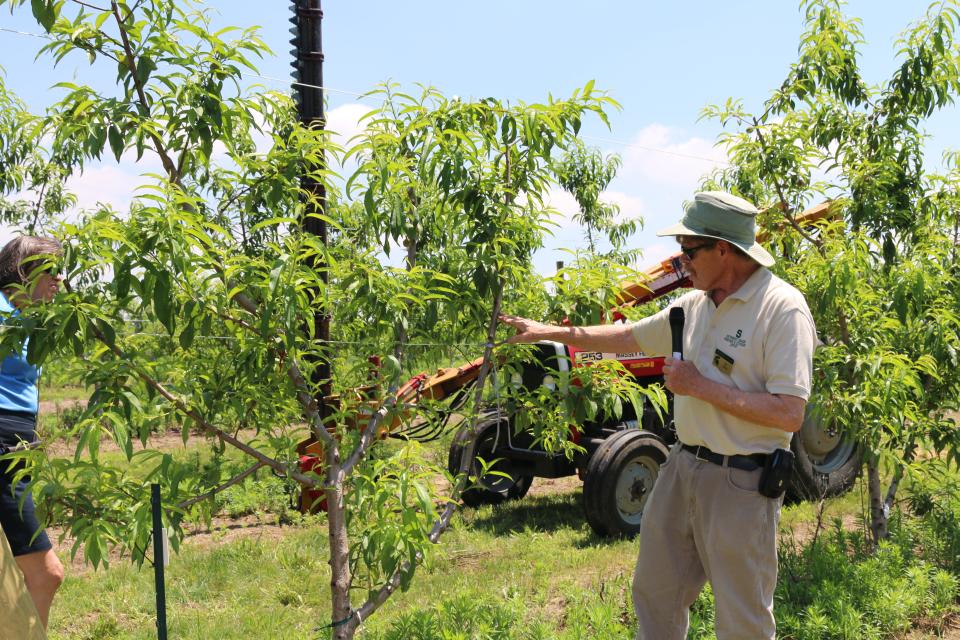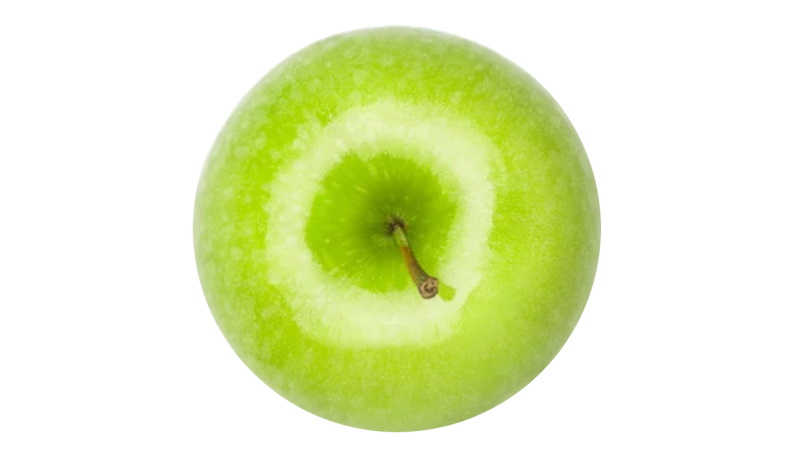Narrow Canopies are the Future of Stone Fruit Production

Bill Shane, MSU Extension Fruit Educator, discusses the type of renewal cuts needed in his palmette peach trellis system in order to keep the trees producing fruiting wood. (Photo: Christina Herrick)
When it comes to peaches, most growers think open vase growing systems are the way to go. But, as Greg Lang, Professor of Horticulture at Michigan State University (MSU) and Bill Shane, MSU Extension Tree Fruit Specialist, noted during a presentation at MSU’s Ag Innovations Day, the future of peach growing hinges on modern growing systems.
Labor shortages are no secret in fruit growing, and all fruit growers should be looking for ways to maximize production but also save on labor.
“A very narrow tree fruit canopy structure is the future,” Lang says. “It’s coming.”
Growing in a narrow canopy allows growers to move away from using ladders in fruit production. As with apples, narrow peach canopies also help develop well-colored, uniform fruit.
“Changing tree architecture gives more light quality, more leaves, more fruit exposed,” Lang says.
In Lang’s cherry growing systems trials, he saw a 40% boost in labor efficiency in narrow canopies.
Easy Move to Mechanization
While V systems and quad-V trees are typically employed in Michigan, Shane and Lang say the V is not a step toward platform use nor is the Darwin string thinner. Narrow canopies also help growers move to mechanization.
Robotic harvesting is no longer a question of if, but when, Lang and Shane say. So, it’s time to modernize peach production to prepare.
“Narrow canopies facilitate mechanization,” Lang says.
A flat canopy is critical when moving to mechanization. Narrow canopies, with less vegetation, present the fruit to a machine’s vision system easily. Lang also noted mechanization includes hedging, mechanized hail netting application, string thinning, etc.
Shane uses a Gillison hedger to shape his trees in mid-June. He also does some summer hand pruning.
“[Using mechanical] Hedgers are a way to make sure you’re sticking to the plan,” Shane says.
Training Branches to Trellis
Shane uses the palmette training system, which got the name because the peach branches fan out and are trained to the trellis.
“You need a stub system because scaffolds want to stop producing fruiting wood,” Shane says.
Tree architecture is vital to this system, as it is for all fruit production. Central leaders are canker magnets, Shane says. So, this modified palmette training system is “a little bit free form.” It’s important to think and plan out leaders in this palmette system, so there is plenty of space between leaders. As the adage says, wide enough to throw a football through.
In the first year of production, Shane allowed the tree to grow out. By the second year, stub cuts were made to keep the canopy narrow. In the third year, regrowth is the key.
“Start thinking about these being the source of new fruiting wood,” Shane says, pointing to stub cuts.
The tops of the trees are not committed to a central leader, instead opting to remove anything wider than a thumb in diameter to mitigate canker risks. Trees are not limited by height, either, thanks to an open canopy.
“We can go taller because we get scattered light in the canopy,” Shane says.
Trees are spaced around 12 to 15 feet apart. In a newer planting in its third leaf at MSU’s Southwest Michigan Research and Extension Center in Benton Harbor, Shane’s rows are about 10 feet apart on Bailey or Lovell rootstocks. Trees are 1¼ feet apart. A new peach planting, Shane says, will be at 12-foot row spacing and about 40,000 trees total. Shane estimates in his 10-foot block, he’ll get 400 bushels to the acre. Shane estimates in his 10-foot block, he’ll get 400 bushels to the acre.
Shane and Lang both say they prefer plastic trellising, like that from Dura-Line, which is not too stretchy. Steel wire can rub along the branches, opening wounds to bacterial canker.
Challenges and Opportunities
Sure, better fruit quality and a boost of labor savings are positives when it comes to moving to high-density fruit production. But it’s important to note that those open canopies that help boost light interception can have some auxiliary issues, Shane says.
“We not only get better quality with the narrow canopies, but we may get more disease blown in,” he says. “We’re in a tough growing environment.”
But Shane says the increased disease risk presents a great opportunity for the MSU peach-breeding program. While looking for optimum selections that offer the sweetness and juiciness consumers crave, stone fruit breeders are also looking at disease resistance as part of a future orchard with narrow canopies and robotic harvesters.
While dwarfing rootstocks for peach production are not commercially available, Lang says there are a few advanced selections that are being looked at by USDA. For now, Shane says instead of dwarfing rootstock controlling vigor, “fruit production will hold the tree in place.”
A Holistic Approach
While narrow canopies are a singular part of peach production, these systems flourish when a holistic approach is taken. The benefits to narrow canopies are to boost tree longevity, grow uniform fruit, and offer picking ease. Those benefits are coupled with labor savings of ladder-free production, mechanized hedging, and blossom thinning,
“It’s not too complicated, but you need to understand this all works together as a system,” Shane says.










